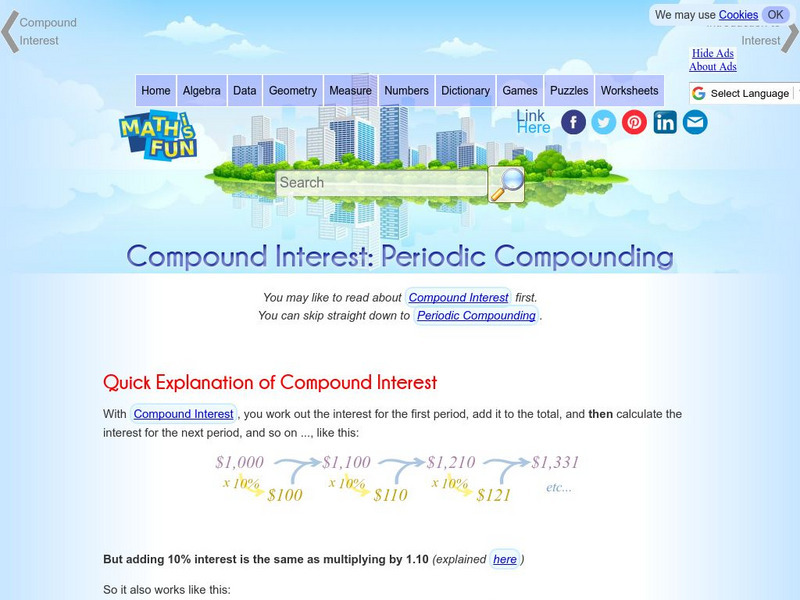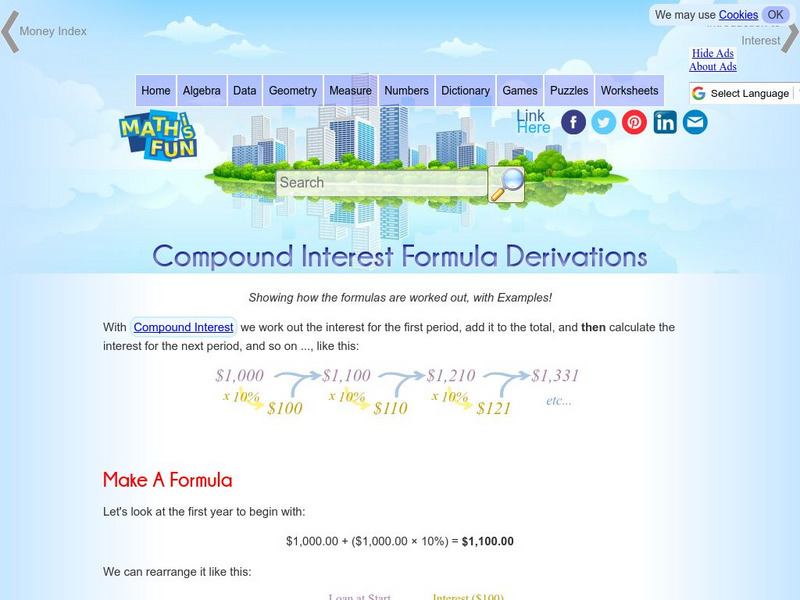Hi, what do you want to do?
Math Is Fun
Math Is Fun: Compound Interest Calculator
A calculator based on the compound interest formula that can be used to determine the Present Value, the Future Value, the Interest Rate, or the Number of Periods. You can select the type of compounding, the effective annual rate, and...
Math Is Fun
Math Is Fun: Compound Interest: Periodic Compounding
Looks at compound interest and at the special circumstances of periodic compounding where interest may be calculated annually or semi-annually, for example, and how that affects the interest rate. Presents examples of different...
Council for Economic Education
Econ Ed Link: Compound Interest Calculator
The activity investigates compound interest, principal, and interest. Students can calculate different savings over time by inputting the monthly savings, starting age, and interest rate. The learning tool includes a graph that shows the...
Math Is Fun
Math Is Fun: Compound Interest Formula Derivations
Looks at how the formula for calculating the effect of compound interest is derived and how it is used to create formulas for finding the Future Value, the Present Value, the Interest Rate, and the Number of Periods. Includes lots of...
CK-12 Foundation
Ck 12: Analysis: Simple and Compound Interest
[Free Registration/Login may be required to access all resource tools.] This lesson provides a summary review of simple interest and exploration of continuously compounding interest. Students examine guided notes, review guided practice,...
CK-12 Foundation
Ck 12: Analysis: Simple and Compound Interest
[Free Registration/Login may be required to access all resource tools.] Students solve real-world problems involving simple and compound interest. Students examine guided notes, review guided practice, watch instructional videos and...
Texas Instruments
Texas Instruments: Compound Interest: Show Me the Money
This is an activity at the conclusion of the exponential relationship unit where students have experience with equations in the form y=a*b^x. Students use the random integer function on theTI-83 Plus to generate a rate of return for the...
University of Nebraska Omaha
Ec Ed Web: M&m Interesting [Pdf]
This site from the University of Omaha provides a lesson plan indicated for 6-8th grades. "During this lesson, students use the economic concepts of trade-offs and opportunity costs to decide between savings accounts with simple interest...
Texas Instruments
Texas Instruments: Numb3 Rs: Financial Futures
Based off of the hit television show NUMB3RS, this activity shows students how money invested at different interest rates grow differently. The lesson focuses on aspects of interest such as compounding, length of time between...
Council for Economic Education
Econ Ed Link: A Penny Saved
Students will read the comic book, "A Penny Saved" published by the New York Federal Reserve Bank. Students will make the information relevant through projects, graphic organizers, teacher instruction, and problems.
University of Nebraska Omaha
University of Omaha: Why We Save [Pdf]
Why do people need to save money? This lesson plan is geared for Kindergarten through 2nd grade and helps students understand the reasons for saving.
Thinkport Education
Maryland Public Television: Sense and Dollars
Engaging, fun tutorials and interactive games related to earning, spending, saving, and budgeting money.
National Council of Teachers of Mathematics
Nctm: Figure This: Play Ball
Make a table to figure out if a baseball valued at $3000 in 1927 is worth more than a baseball valued at $3 million in 1999. Which is a better investment?
Calculator Soup
Calculator Soup: Savings Calculator
Calculates the future value of your savings account. With a starting balance and regular deposits, learn how much can you save.












![Ec Ed Web: M&m Interesting [Pdf] Lesson Plan Ec Ed Web: M&m Interesting [Pdf] Lesson Plan](https://static.lp.lexp.cloud/images/attachment_defaults/resource/large/FPO-knovation.png)

